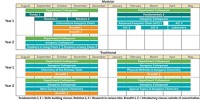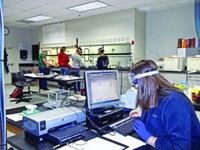Advertisement
Grab your lab coat. Let's get started
Welcome!
Welcome!
Create an account below to get 6 C&EN articles per month, receive newsletters and more - all free.
It seems this is your first time logging in online. Please enter the following information to continue.
As an ACS member you automatically get access to this site. All we need is few more details to create your reading experience.
Not you? Sign in with a different account.
Not you? Sign in with a different account.
ERROR 1
ERROR 1
ERROR 2
ERROR 2
ERROR 2
ERROR 2
ERROR 2
Password and Confirm password must match.
If you have an ACS member number, please enter it here so we can link this account to your membership. (optional)
ERROR 2
ACS values your privacy. By submitting your information, you are gaining access to C&EN and subscribing to our weekly newsletter. We use the information you provide to make your reading experience better, and we will never sell your data to third party members.
Education
Revisiting The Premed Curriculum
Updating premedical education to reflect modern science could improve the experience for other students, too
by Celia Henry Arnaud
November 2, 2009
| A version of this story appeared in
Volume 87, Issue 44

Look around any undergraduate organic chemistry class. Chances are most of the students in attendance are planning to go to medical school. Medical school entrance requirements drive much of the undergrad science curriculum, but many educators have grown concerned that the requirements have not kept pace with modern science. In fact, they have changed very little since American educator Abraham Flexner’s 1910 report, “Medical Education in the United States and Canada,” first established the need for a scientific basis for medical training.
Those requirements are now being revisited. In the report “Scientific Foundations for Future Physicians,” published this summer, the Howard Hughes Medical Institute (HHMI) and the Association of American Medical Colleges (AAMC) laid out the basic scientific knowledge needed by modern physicians. HHMI undertook writing the report, enlisting AAMC’s help, as a direct result of the recommendations in the 2002 National Research Council report “Bio 2010,” which urged educators to revise the premed curriculum to acknowledge how much science has changed, says Peter J. Bruns, vice president for grants and special programs at HHMI. “We needed to say what basic science does a person graduating from medical school need and when they should get it,” he says. “That brings you back to premed.”
If educators heed the new report, the old requirements of a year each of biology, chemistry, physics, organic chemistry, and calculus will be replaced by a set of competencies that specify content rather than courses. The report lists 16 competencies that are split equally between medical school and undergrad premedical education. Each competency is fleshed out with a number of learning objectives that are defined by examples.
The report paints its competencies and learning objectives with broad brushstrokes. For example, the undergraduate competency most relevant to chemistry simply says, “Demonstrate knowledge of basic principles of chemistry and some of their applications to the understanding of living systems.” Even the learning objective directly related to organic chemistry says only, “Demonstrate knowledge of the chemistry of carbon-containing compounds relevant to their behavior in an aqueous environment.”
The competencies are meant to bring the premedical curriculum in line with modern science. For example, the mathematics competency deemphasizes calculus but stresses the growing importance of statistics and databases. The chemistry competencies acknowledge the importance of general and organic chemistry, but organic chemistry in aqueous environments is explicitly mentioned. For the first time, biochemistry is included as part of the premed competencies.
The hope is that the HHMI/AAMC report will liberate the undergraduate science curriculum from the shackles of medical school entrance requirements and encourage innovations such as interdisciplinary courses.
In the past, general and organic chemistry courses have been guided by MCAT (the Medical College Admission Test) and American Chemical Society guidelines, says Karin S. Åkerfeldt, a chemistry professor at Haverford College, in Pennsylvania, and a member of the committee that wrote the report. “We have pretty much been teaching the first two years of introductory courses the same way for decades.”
MORE COVERAGE
Visit C&ENtral Science to read Celia's blog entry related to this story
Gregory A. Petsko, another committee member and a professor of chemistry and biochemistry at Brandeis University, agrees. “I’m disheartened by the way we teach the sciences, especially to premedical students. We tend to create a generation of students who have had most of their scientific curiosity beaten out of them,” he says. “I could teach freshman chemistry in almost any university in this country today using the same book and the same set of notes I used when I took the course 40 years ago. That’s not right.”
One way to address the recommendations in the report would be to provide separate tracks for premed students and those planning to become scientists. Many schools don’t have the resources to take such an approach.
“We’re going to have to cater to all science students using the same basic introductory courses,” Åkerfeldt says. “Initially, there’s probably going to be a certain set of courses that are maybe not so different from those we’re already offering as the premed required courses. Over time, however, you can see how the new guidelines can give departments the flexibility to rearrange the way they teach the introductory two years. This will allow us the flexibility to be innovative and teach across the sciences.”
Before the report was released, there were rumblings in the blogosphere about premeds no longer being required to take organic chemistry. Such fears appear to be unfounded.
Edward A. Dennis, a professor of chemistry and biochemistry at the University of California, San Diego, points out that the report recommends a significant amount of biochemistry in both the undergrad and medical school curricula.
“There’s no way you can teach undergraduate biochemistry without having some organic chemistry background,” Dennis says. “Even if the report says that the requirement for med school should be biochemistry, the undergraduate schools should not allow somebody to take biochemistry without a modicum of organic chemistry first. You cannot understand even the college-level biochemistry without the organic principles behind it. While the report shied away from explicitly requiring organic chemistry, it seems implicit in how you teach biochemistry.”
The question might be whether the recommendations will allow chemistry departments to reorganize the way they’ve been teaching organic chemistry.

The recommendations are “giving a lot of freedom to the colleges to reorganize their courses in interdisciplinary ways, and they don’t have to be called by the traditional names,” Dennis says. “You certainly need the principles of chemistry to begin to understand organic chemistry, and you need the principles of organic to understand biochemistry. But you could imagine integrated curricula that use more biochemical topics as examples of some of those principles. One could imagine college curricula being more efficient at getting somebody up to speed in biochemistry than the traditional whole year of chemistry, whole year of organic, and whole year of biochemistry.”
The report opens the door to the development of integrated approaches to science education. One course that already takes such an integrated approach is Harvard University’s series of introductory courses, Life Sciences 1a and 1b (C&EN, July 17, 2006, page 43).
“We feel very much affirmed by this report,” says Robert A. Lue, professor of molecular and cellular biology and director of education in Harvard’s Division of Life Sciences. “The conception of what it takes at the foundation level to train the next generation of great scientists is convergent with what it takes to train the next generation of great physicians. We do not make a distinction between science majors and nonscience majors that may go on to medical school. We feel everybody should have a foundation that’s reflective of the sciences today.”
Petsko suggests an even more radically flexible approach to the chemistry curriculum. “I’d divide the students into groups of 50 and assign each group to a single chemistry faculty member for two years. For two years, that faculty member would teach those 50 students general chemistry, organic chemistry, and biochemistry,” he says. The faculty member would have free rein to organize the course any way he or she saw fit, as long as the necessary information was included at some point. At the end of the two-year cycle, the professor would have a year off.
“You’d know their strengths and weaknesses and you could work out as a team—you and the students—how best to learn this stuff,” Petsko continues. “You’ve got two years to do it any way you want to. I think that would be a really exciting educational experiment. It would create a kind of educational atmosphere the likes of which we haven’t had in American universities maybe ever and maybe not in most universities since the days of Socrates.”
He realizes, however, that such an idea is likely too expensive to come about. “In a place like Brandeis, you’d have to hire at least six new faculty,” Petsko says. “We just don’t have enough people to do it.”
This report comes at a good time for schools that are already exploring changes to their curricula. Ohio State University, for example, is in the process of converting from quarters to semesters.
The switch to semesters “presents a great opportunity for me to rethink my entire curriculum, not just for the med students, but for everybody to be able to try to provide the best instruction to any of our majors,” says Christopher M. Hadad, vice chair for undergraduate studies in the chemistry department at Ohio State.
Ohio State is currently considering whether to have one organic chemistry track for chemistry and chemical engineering majors and another track for biologically oriented students, including premeds. “One of the concerns we have is if you have a tailored course that’s just ideal for premed but doesn’t train those students to be effective in any other discipline, that’s a real disservice to the student,” Hadad says. “What do they do if they don’t get into medical school?”
The chemistry department faculty at the University of Illinois, Urbana-Champaign, are reviewing their entire undergraduate curriculum, independent of the HHMI/AAMC report. “This report reinforces the kinds of things we’re looking at,” says Steven C. Zimmerman, head of the chemistry department at Illinois. “We feel that science is being taught in a compartmentalized fashion. We’re thinking about overhauling the curriculum in a way that the traditional boundaries between the subareas in chemistry might disappear. We’re even talking about not having something called organic chemistry.”
Some of the loudest voices complaining about organic chemistry are physicians themselves, who say that they never use what they learned in those courses. But not all physicians express such sentiments. A retired neurologist who writes a blog called “Chemiotics II”—which covers topics including molecular biology, organic chemistry, medicine, and mathematics—and who goes by the handle “luysii” recently expressed in a post thoughts about why all premed students should take and pass organic chemistry. Using U.S. Supreme Court Justice Sonia Sotomayor, her diabetes, and the H1N1 virus as examples, luysii illustrated how the type of thinking fostered by organic chemistry is regularly needed by physicians as they confront new situations. “Anyone without the particular type of mind that is able [to] absorb and apply multiple and (often) conflicting principles doesn’t belong in medicine,” luysii wrote.
Ronald C. Breslow, a chemistry professor at Columbia University, similarly worries that the distinction between education and training might be getting lost. He points out that premedical and medical education should involve more than just telling students about existing treatments. Chemistry education “prepares you to understand the new chemistry that’s going to come out and be relevant in terms of other things you already know,” he says. Breslow likes to use the nonchemical example of Euclidean geometry. “How much of what I learned in Euclidean geometry do I use now?” he asks. “I never sit down and do a Euclidean proof, but I learned a huge amount about what constitutes a real proof. I use that all the time.”
In addition, Breslow says, students need the freedom to change their minds. “Students do not arrive in college with ‘premed’ tattooed on their foreheads,” he says. “The courses they get should also make it possible for them to become scientists, not just physicians, if they discover—as many do—that they want to become chemists or biologists as a way to advance medical progress and scientific understanding.”
The report might not spur the desired education reform unless changes in the MCAT, which is administered by AAMC, reflect the recommendations in the report.
“If the folks who run the MCAT exam pay attention to it, then eventually the universities will have to pay attention to it, too,” Petsko says. “The only way change is going to happen is if a gun is put to the head of the universities. The MCATs are the gun, or at least the bullets.”
Zimmerman of Illinois says that graduate admissions tests—both the MCAT and the Graduate Record Examination (GRE)—can either help or hinder educational reform.
Advertisement
“It would be huge if it ended up that what we’re teaching is not preparing students adequately for the MCAT. The same is true for the GRE,” Zimmerman says. “If your customers are not getting what they need to succeed in their careers, then you’ve got a bad product. We can come up with what we think is a fabulous chemistry curriculum, but if our students score 20% on the chemistry GRE and can’t get into top graduate schools, we’ve done them a disservice.”
Such reforms could be in the works. A second AAMC committee is reviewing the MCAT, with an eye to the recommendations in this report and a similar one on the social sciences that is expected next year. A revised MCAT would be introduced no earlier than 2013.
Such external forces might be enough to encourage changes in the undergraduate curriculum. “Ultimately, it’s going to be a question of enough people saying the way we’re doing things isn’t really working all that well. We’re fooling ourselves if we think it is,” Petsko says. “We need to do it differently. Even though it may involve a lot of work and a lot of headaches, we’re just going to have to bite that bullet.”





Join the conversation
Contact the reporter
Submit a Letter to the Editor for publication
Engage with us on Twitter